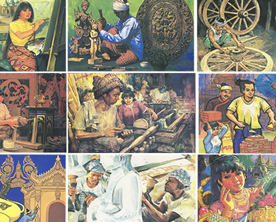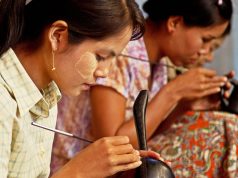Myanmar’s religious and deeply traditional culture has contributed to a thriving arts and crafts scene for many centuries. Although other countries have begun to lose touch with their roots, Myanmar continues to practice and celebrate its ancient customs through a range of creative outlets. Heavily influenced by Buddhism, many of the arts and crafts produced in Myanmar play a critical role in everyday life. Not only locals but also tourists are showing keen interest to buy into unique Myanmar’s arts and crafts.
There are ten best well-known traditional arts and crafts called “Pan Sel Myo” (10 types of flowers). They are:
- Panchi (Painting): Pronounced as “ Bagyi”. It is the art of painting that shows live animals and inanimate objects using different colors. Artists paint the figures of beings, animals, objects, drawings and caricatures.
- Punpu: Pronounced as “ Bapu”. The art of sculpture producing figures and floral motifs made of wood. Artisans make the figures of men, animals and floral motifs. Myanmar traditional sculpture emerged before the Bagan period and improved in the middle ages of the Bagan Era.
- Panbe: Pronounced as “Babear”. It is a kind of Blacksmith, tempering of the iron in the oven to make the necessary tools. The craftsmen make oxcart axles, oxcart irons, scissors, hammers, pick axes, knives, axes, hoes and dig hoes. The traditional craft of Babear originates during the early Baganera and improved through the middle periods of Bagan, Inwa and Yadanarpon.
- Panyun: Pronounced as “Payun”. It means handicraft, which produces materials made of bamboo and polishing with a thick black varnish (“sis-se” in Myanmar language). These lacquerware craftsmen produce alms food bowls, bowls for monks, lacquer ware vessels, drinking cups and various types of boxes.
- Panpoot: Pronounced as “Baput”. It is the art of making materials by rubbing and turning woods on the lathe turner. Craftsmen make the shafts for umbrellas, table legs, the legs of beds, rotary seats and halls and stairs railings.
- Panyan: Pronounced as “Payan”. It is the art of masonry constructing the buildings with brick, stone, concrete and cement. The masons build brick houses, pagodas, bridges, etc
- Pantaut: It means the craft of making decorative floral designs with stucco embossed. The craftsmen make the figures of lions, dragons and floral designs with stucco.
- Pantamaut: It is the art of stones curving. The craftsmen make Buddha images, pillars, elephants, deer, circular flat stone pestles, mortars and tables
- Patain: Pronounced as “Badain”. It is making the art of objects with gold or silver.
- Patain: Pronounced as “Badain”. It is making the art of objects with gold or silver. (10) Pante: Pronounced as “Badee”. Pante is the art of making materials with copper, bronze or brass. The craftsmen make triangular brass gongs, copper pots, trays, boilers, cup bowls, dishes and cymbals.
Besides the above ten arts, Pottery, Mosaic, Tapestry, Lapidary, Lotus textile Weaving, Gold Foil Making, Silversmith, Wooden Parquetry, Wall Painting, Silk Weaving, Marionettes or Puppet, Silk Umbrella, Rattan (Cane) and Water Hyacinth Products are also popular as Myanmar traditional arts. Myanmar Arts and Crafts reflect a rich culture, arts and architectures of the country










